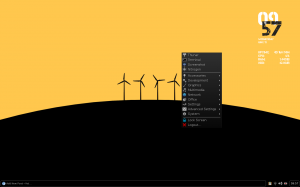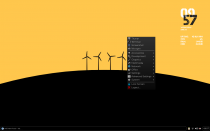 I’ve been running Manjaro Linux Openbox Edition since about November of 2013. I haven’t re-installed…since Manjaro rolls with it’s releases…I haven’t needed to re-install. It’s been as steady as a rock for 2 releases and many months of torture and pain from yours truly.
I’ve been running Manjaro Linux Openbox Edition since about November of 2013. I haven’t re-installed…since Manjaro rolls with it’s releases…I haven’t needed to re-install. It’s been as steady as a rock for 2 releases and many months of torture and pain from yours truly.
The only other distribution I’ve ever put through its paces like this that remained stable and usable was Salix…which is Slackware based. Manjaro is Arch based and benefits greatly from the fantastic package manager ‘pacman’. Oddly enough, Salix has a lot in common with Manjaro in that they both attempt to bring simplicity with easy upgrades/updates. They also both tap into the community for customized packages…Salix with the ability to install Slack builds and Manjaro with the ability to add on packages from the AUR (Arch User Repository). Both provide tools that allow a user to interface with these user built repositories. Both are lightning fast and use a very low amount of resources.
Even though I’d hadn’t noticed before….they do have a lot in common.
I’ve demanded a lot more from my Linux distributions lately…I haven’t picked the ones I use based on what everyone else is using. I haven’t picked one that has recently released. I picked one that doesn’t decide what’s best for you. I think this approach is best…doing less is more.
I don’t want a distribution to install the entire KDE application suite out of the gate taking up tons of space on my hard drive and making my Kmenu a jumbled mess. I don’t want a distribution that doesn’t install tons of applications but is so bloated and lethargic on the desktop that I can barely function. I don’t want a distribution that does things the wrong way by requiring me to install more than what I need (thanks meta packages!). The bottom line is, I want a simple distribution of Linux that truly and wholly supports the ‘less is more’ mantra. The only two I’ve settled on are Manjaro and Salix. I’m not saying these are the only ones that ascribe to this mantra…I’m just saying these are the only two I’ve used that I like. I’m sure there are others you might have found do the same thing and I’d encourage you to leave a comment with this distribution so that I can check it out.
I don’t do a lot of Linux reviews…but I will be doing a Salix and Manjaro one in the near future. I think they both deserve any amount of press they get because they are fantastically simple distributions.

I just wanted to share my site where I gathered all redhat linux solutions, just search for error and you get solution for anything.
http://www.iamlinux.com
If you find this setup works for you then more power to you. I on the other hand tried more simple. But found my needs outweighed the DE. Meaning more mature and feature rich applications that gave me what I needed. And that wasn’t a stripped down simpler DE.
“I don’t want a distribution to install the entire KDE application suite
out of the gate taking up tons of space on my hard drive and making my
Kmenu a jumbled mess.”
Yep sounds like you also needed or wanted more capable applications that KDE delivers. But mixing with other WM’s or DE’s gave the mess you described.
“I don’t want a distribution that doesn’t install tons of applications
but is so bloated and lethargic on the desktop that I can barely
function.”
From my perspective that hasn’t been my experience. I have a older dual core and 4gb of ram. And ALL my KDE spins chime in to desktop 380-420mb. All smooth & Snappy without issues using the default open drivers on my dual 22″ displays. In fact this wasn’t the case for Cinnamon,Unity & Gnome 3 came in heavier and not as smooth on my system. And another issue is unused ram is wasted ram. So I rarely use swap or reach 3-4gb range of my ram anyways. So how lightweight it boots to desktop is really irrelevant to me. But how fast apps load and respond do and do not find that an issue in KDE for me.
“I don’t want a distribution to install the entire KDE application suite out of the gate taking up tons of space on my hard drive”
Recent hardrives shouldn’t be an issue. But what is Tons of Space? I have a 11Gb / and 12Gb /home. And all the apps I need in Netrunner KDE rolling. So we are talking under 25Gb here. As all my data are on external usb and other data internal data partitions.
“I want a simple distribution of Linux that truly and wholly supports the ‘less is more’ mantra. ”
Use to live by that mantra. And ran Gnome 2 ubuntu and such. But found the lack of mature and more featured apps lacking. Got tired of running 2 or 3 apps to get the job done when one app in KDE did the same. So bit the bullet and went full in with KDE. And for me been the best choice for me and my needs.
Again glad you found yours for you and your needs. But please do not spread FUD about being a resource hog or bloated. As in today’s world that isn’t the case. I find many other DE’s that take up more resources and they never get the “Bloated” or “Hog” labels. Like many the do take more ram and tad less responsive than the stripped down lightweight versions you mentioned. But at the cost of functionality and desktop features that others want. As everything in life it’s a tradeoff vs. needs and wants.
.
FUD? Seriously? For stating that I want a slim installation optimized for speed without clutter on my desktop? Like Salix KDE or Manjaro based Netrunner?
I think you read this entire article thinking that I’m trying to take a swipe at KDE…farthest thing from the case. I’ve been an ardent supporter of KDE for many, many years and even helped develop distributions of Linux (PCLinuxOS, Mandrake/Mandriva) using KDE as default DE for many years.
I’m afraid you may have read this article set at finding something you could complain about when you shouldn’t have.
As an example, here are some of my many articles on KDE:
http://linux-blog.org/hate-kde4-ignorance-is-probably-the-culprit/
http://linux-blog.org/manjaro-kde-notes/
http://linux-blog.org/comic-books-linux-and-kde-4/
http://linux-blog.org/kde-shortcut-keys/
http://linux-blog.org/kde-and-xorg-fonts-and-dpi/
http://linux-blog.org/kde-right-click-extract-here/
http://linux-blog.org/convert-audio-with-ease-in-kde/
http://linux-blog.org/netrunner-best-distro-youve-barely-heard/
Now, please…try not to throw drive-by accusations after reading an article without context and in the wrong tone.
I’m not hating you. Just trying to put a stop to words like Heavy,Resource Hog,Less responsive to specifically KDE. I see this all the time used describing KDE and rarely see used in context to Unity,Cinnamon & Gnome 3.
Sorry if you got that impression of me attacking you. And maybe I should back-pedal a bit and not be so vehement in my responses. Just getting so tired of every description or review of KDE seems to have to use words like Heavy,Resource Intensive,Hog,Bloated,etc… And then turn around and read reviews about Unity,Cinnamon or Gnome 3 and not see those words.
Again sorry if I came across too Heavy Handed and glad you are finding a great solution that works for you.
I’m with you…I find Netrunner is pretty solid on this exact same machine and it doesn’t feel bloated at all.
Yep only reason I went with arch-based was needing newer kernel and fresher apps for supporting my Huion Graphics Tablet. Otherwise I was pretty happy with SolyXK KDE spin. All the KDE spins I have tried didn’t install too many extra apps. And all always chimed in to desktop around the 400mb mark. And pretty smooth and snappy trouble-free experience using the open default drivers.
Again sorry about being an old grouchily ole’ Fart!..Wait I Am an old crouchedity Old Fart! 🙂
Guys,
I really want to recommended you if you are looking for programming language
such as LINUX, RHCE, RHCSA and more. then Grras is perfect place for all of
you. They are providing teaching in both ON-LINE and OFF-LINE mode.
For more info please visit here :- http://rhceinjaipur.com/